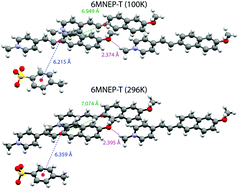6MNEP: a molecular cation with large hyperpolarizability and promise for nonlinear optical applications†
Abstract
Molecular organic crystals are strategically designed for nonlinear optical applications using push–pull chromophores as the core feature. In this approach, electron-donating and accepting groups are connected through a π-conjugated bridge to obtain planar molecules with high hyperpolarizability. However, the non-centrosymmetric packing that is required for nonlinear optical (NLO) applications is a critical challenge that must be addressed to design useful materials. In this article, we present the new organic cation 6MNEP that shows a large hyperpolarizability and can be crystallized in ideal non-centrosymmetric structures for NLO applications, when paired with T and 4NBS anions. The 6MNEP cation was obtained by extending the conjugation length of already existing chromophores. We compare the 6MNEP crystals with other crystals that also have cations with extended conjugation lengths, but result in centrosymmetric crystal structures. Using the effective hyperpolarizability, we found 6MNEP-T and 6MNEP-4NBS to have 1.6 to 2.5 times larger macroscopic nonlinearities than benchmark NLO organic crystals. Additionally, the significantly lower absorption wavelength compared with other state-of-the-art crystals make 6MNEP-T and 6MNEP-4NBS promising materials for NLO applications like intense terahertz generation.



 Please wait while we load your content...
Please wait while we load your content...